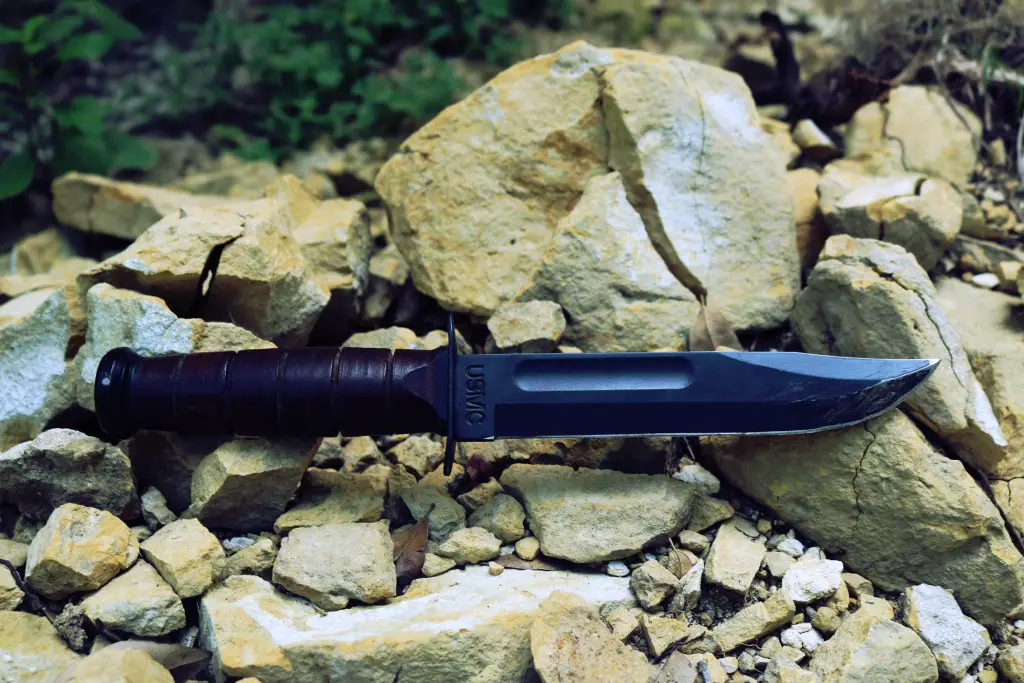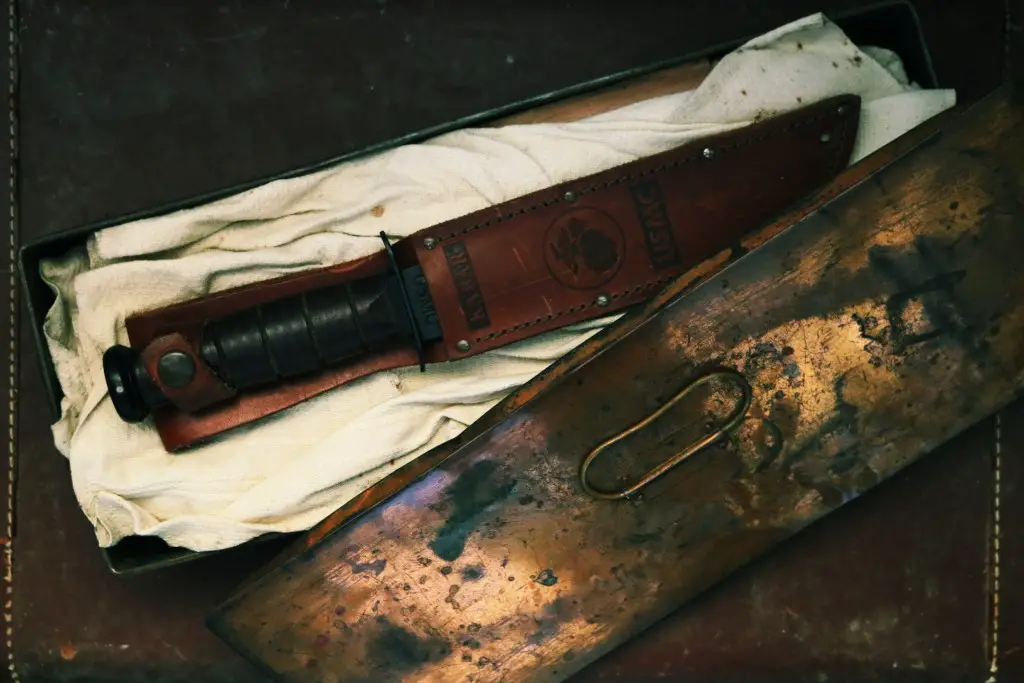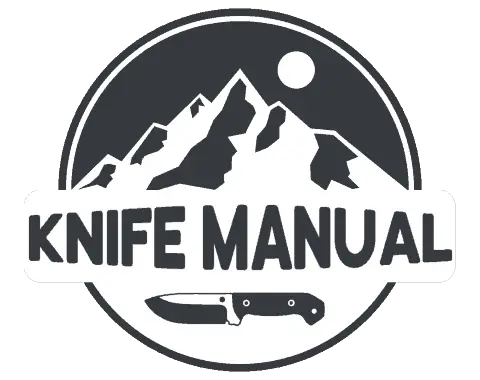The iconic Bowie knife. Instantly recognizable for its trademark clipped edge, has become a symbol of lawlessness, fighting, and the wilderness. Although this type of knife was originally developed for fighting and self-defense, you’d be surprised at the level of use it can provide when it’s every man for himself and you need to survive.
A Bowie knife can be very useful and good in a survival situation. Its sturdy build will ensure it survives – along with you – through the harshest conditions imaginable. With a nice heavy blade, a Bowie knife is able to chop, cut, and slash with ease, while also being slim and agile enough to carve and prepare food.
Table of Contents
What are the Characteristics of a Bowie Knife?
When many people think of knives, one of the first images that pop into their brains is of a Bowie knife. The simple design of a Bowie knife has become an icon and can be recognized by almost anybody. But what is it that turns a standard knife into a Bowie knife?
The most defining feature of the famed Bowie knife is almost hands down the clipped edge. And while this feature is the most noted and famous, it is not the only unique thing that makes a Bowie knife a Bowie knife.
The first Bowie knives were originally designed and made for fighting. Because of this specialized need, a finger guard at the base of the blade along with many other features was built into the knife. Another thing that was added for ease of fighting with the knife, was a heavy blade. This was added so that a single swipe of the blade could cut easily through flesh.
To be considered a Bowie knife, the main criteria is often a fixed, heavy blade, a fingerguard, and a clipped edge. While these are the basics of the original Bowie knives, many modern designs often include things like a partially serrated edge. A few other types of knives meet all of these criteria and yet are not considered Bowie knives. This mainly comes down to preference and aesthetics. Many standard tactical knives meet the Bowie knife requirements and yet are considered tactical knives because of aesthetics and feel.
Traits You Should Look for in a Survival Bowie Knife
While just looking for the basic traits of a Bowie knife will result in a very nice survival tool. Since the original design was meant for fighting and hand-to-hand combat, a different set of criteria should be sought after for survival purposes.
The main trait to look for in a good survival Bowie knife is a full tang. Many Bowie knives made today are partial tang or rat-tailed. This is because they are often made for show and decorative purposes, and not with heavy, survival uses in mind. There is not a shortage of full tang Bowie knives out there, however, just make sure you get one that has a full tang if you intend to use it for survival or in your bug out bag.
Check out this article to learn what knife tang is and the different uses for the different types of tang.
The next thing to look for in a survival Bowie knife is a lighter blade and one that does not exceed ten inches. When you are using your knife a lot and having to carry it around, often it is nice to have a slightly lighter blade that allows the entire knife to weigh around ten or twelve ounces. A shorter blade will also help in lowering the weight of the knife.
While some Bowie knives can exceed more than thirty inches total, for survival purposes that would be very impractical. In this case, bigger doesn’t necessarily mean better. Picking a knife that has a blade length of around ten inches or smaller would best suit the needs of a survivalist.

Be aware that any of these suggestions can be taken too far. A one-ounce Bowie knife with a two-inch blade would not make a great survival knife. It is necessary to keep a little weight and length in a good survival Bowie knife because when you are caught in a survival situation, your knife will serve many more purposes than just a knife. It will become a baton, a weapon, a fire starter, a shelter builder, and countless other things.
Lastly, a good, solid sheath for your Bowie knife is a must. I would recommend a heavy-duty leather sheath, but other nylons and plastic sheaths are a good choice as well. Just keep in mind the drawbacks of each kind of sheath.
For a plastic or nylon sheath to he hardy enough for survival purposes, they often need a hard plastic insert. This can be useful because of ease of cleaning, but can also be a drawback if your knife rattles and easily falls out of the sheath because of the insert. Plastic sheaths often crack after a long time of use or being left out in the elements. Personally, I would go with a leather sheath for your survival Bowie knife.
While leather is hardy, doesn’t need a plastic insert, and is reasonably easy to clean, it needs some maintenance to ensure it doesn’t become brittle and allow your knife to cut through it. Keeping the leather conditioned and oiled is an extra hassle, but is well worth the extra durability over the other plastic and nylon options.

Ways You Can Use a Bowie Knife During Survival
A Bowie knife is like the gaff tape of the knife world. It can fix any problem imaginable. So as you can imagine, there is nearly an endless list of ways your Bowie knife can aid you in a survival situation.
A major thing that a Bowie knife can do that sets it apart from other survival knives is chop. Even a lighter Bowie knife blade is still pretty heavy and will often be able to chop and bushwack if needed. When it was first invented, Bowie knives were just considered butcher knives and small swords. And this similarity didn’t just pop up out of nowhere. A Bowie knife is and can be used as a sort of machete or sword when needed.
So whenever the situation arises, don’t ask if your Bowie knife can handle it, ask how. Go beyond what a traditional survival knife can accomplish, and look at what a Bowie knife can.
Okay, that was cheesy.
But for real, a Bowie knife can be used just like a regular knife in a survival situation but with the added benefit of a larger and heavier blade.
So… are Bowie Knives Good for Survival?
Yes and no. in this article I’ve mainly focused on the good aspects of a survival Bowie knife. But as always, there are drawbacks to having a Bowie knife instead of a traditional survival knife.
First off size, weight, and practicality. A good survival knife needs to be easy to carry while also being heavy and big enough to complete difficult tasks. You have to find the sweet spot between the two that makes the most sense and allows the knife to be the most practical and useful it can be.
So this is what it comes down to. Bowie knives are good for survival but aren’t the best.
It mainly just comes down to personal preference whether you want a Bowie knife or a traditional survival knife. Consider your options and look at what you are really going to be using your knife for. If it is heavy tasks such as batoning, bushwacking, or self-defense. Go for a good ol’ Bowie knife. If you are going to need a survival knife for smaller and less taxing tasks, consider a lighter and smaller survival knife.
No matter what survival knife you end up with, there will always come a time when you must sharpen your blade while in the wilderness. to learn how you can sharpen a knife in the woods with little to no modern equipment, check out this article.


